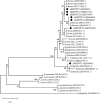Probiotic Properties of Enterococcus Isolated From Artisanal Dairy Products
- PMID: 30863379
- PMCID: PMC6400110
- DOI: 10.3389/fmicb.2019.00300
Probiotic Properties of Enterococcus Isolated From Artisanal Dairy Products
Abstract
The present study focused on probiotic characterization and safety evaluation of Enterococcus isolates from different artisanal dairy products. All the isolates exhibited inhibitory activity against several food spoilage bacteria and food-borne pathogens, including Shigella flexneri, Staphylococcus aureus, Listeria monocytogenes, Yersinia enterocolitica, Klebsiella pneumoniae, Escherichia coli, and Bacillus subtilis. The PCR results indicated the presence of at least one enterocin structural gene in all the tested strains. The Enterococcus isolates were further evaluated regarding their safety properties and functional features. The isolates were susceptible to vancomycin, gentamycin, and chloramphenicol. The results of PCR amplification revealed that all the tested isolates harbored none of the tested virulence genes except E. faecalis (ES9), which showed the presence of esp gene. The Enterococcus isolates showed cholesterol lowering properties. The selected isolates showed a high tolerance to low pH, and toward bile salts. They also demonstrated hydrophobicity activity, auto-aggregation, and adhesion ability to the human intestinal Caco-2 cell line. These properties may contribute the bacteria colonizing the gut. This study revealed that the Enterococcus isolates, especially E. durans ES11, ES20 and ES32, might be excellent candidates for production of functional foods to promote health benefits.
Keywords: Enterococcus; Enterococcus as probiotics; antimicrobial activity; dairy products; low cholesterol; probiotic properties; safety evaluation; virulence factors.
Figures


References
-
- Angmo K., Kumari A., Bhalla T. C. (2016). Probiotic characterization of lactic acid bacteria isolated from fermented foods and beverage of Ladakh. LWT Food Sci. Technol. 66 428–435. 10.1016/j.lwt.2015.10.057 - DOI
LinkOut - more resources
Full Text Sources
Molecular Biology Databases

